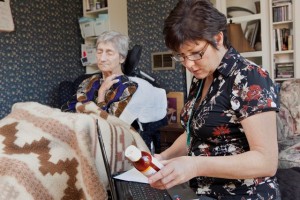A new approach to palliative care in the community
A palliative patient at home. Most Canadians indicate that, if given the choice, they would choose to die at home with loved ones, yet almost 70 per cent of deaths occur in hospital. As well, there is an ongoing need for acute care beds in hospitals – in-home palliative care would save these beds for those who need it most while giving end-of-life patients a choice in where to spend their final days. We know that addressing how people age is of great importance, but we also need to shine a light on delivering end-of-life care that is both effective and supportive for our patients, their families, and their circle of care. In the past, here in Toronto, palliative care in the community

Most Canadians indicate that, if given the choice, they would choose to die at home with loved ones, yet almost 70 per cent of deaths occur in hospital. As well, there is an ongoing need for acute care beds in hospitals – in-home palliative care would save these beds for those who need it most while giving end-of-life patients a choice in where to spend their final days. We know that addressing how people age is of great importance, but we also need to shine a light on delivering end-of-life care that is both effective and supportive for our patients, their families, and their circle of care.
In the past, here in Toronto, palliative care in the community was delivered by numerous health care professionals for each patient, and many felt a burden in having to repeat their stories to each health care provider that they would encounter. From physicians to nurses, homecare workers and more, it wouldn’t be uncommon for a palliative patient and their family to interact with multiple care providers.
MORE: THE ASSISTED DYING DEBATE
Though well intentioned, this model does not provide clarity or comfort for patients and their loved ones during such a difficult time. Dealing with the end-of-life of a loved one is stressful enough, but having to interact with what may feel like a revolving door of care providers while not having any freedom of choice only compounds the situation. Patients and their families need to feel secure and confident that their care team will deliver the best possible care that meets their unique needs, while focusing on what means most to them during this important time.
For many years, the Toronto Central Community Care Access Centre (CCAC) worked in tandem with health care team partners including the Temmy Letner Centre for Palliative Care (Mount Sinai Hospital) and Toronto Hospice to deliver patient care. Together as partners delivering palliative care, we recognized the need for a new care model to ensure patients experienced one care team. We wanted to know how patients and their families felt about their care team, and how we could improve their experience. We asked for their feedback, and listened very carefully. Working closely with our partners, we knew that offering a “one team” experience for patients and their caregivers was paramount in raising their confidence in their care team, feeling more secure in the services we provided, and ultimately gave them the power of choice. With their comfort and well-being as the focus, the method of how they would be cared for was closely examined.
The integrated care team, comprised of hospice workers, CCAC Care Coordinators, Nurses, and Physicians, made some big changes to care delivery in the community. We instituted innovations that included a palliative huddle, written client records in home, streamlined communication tools (providing caregivers with one phone number to access the services they need, rather than multiple numbers for multiple needs), and joint patient assessments. We are currently creating an electronic medical record, accessible by the client’s circle of care, as a standard for all patients. Changing partner communications and restructuring teams resulted in this “one team” approach. Though a patient could receive care from many members of the care team from numerous organizations, they now recognize them by name and as part of a single care team – unaware of the organization they work for. They are often delighted to know that when another care team member enters their home, they are already equipped with knowledge of the patient and their care history. In keeping with the mandate to provide outstanding care, the new CCAC palliative model has allowed family members and those in the end stages of life to have choices.
MORE: REINVENTING PALLIATIVE CARE FOR PATIENTS WITH DEMENTIA
This new palliative model has allowed families and those at the end-of-life to have a choice not only about their quality of life, but how and where they would like to spend their final days – within a medical environment or surrounded by loved ones at home.
Here’s an excerpt from a recent email we received from a palliative patient’s caregiver: “No words could ever express the deep gratitude I feel to these wonderful people and the caring meaningful way they helped me survive this very difficult time, and made it possible for our loved one to be at home until the end. They were more than caregivers, they became family, and that made all the difference. Thank God for this team, they will forever be in my prayers.”
And that’s what matters most.
The post A new approach to palliative care in the community appeared first on Hospital News.
SOURCE: Hospital News – Read entire story here.









